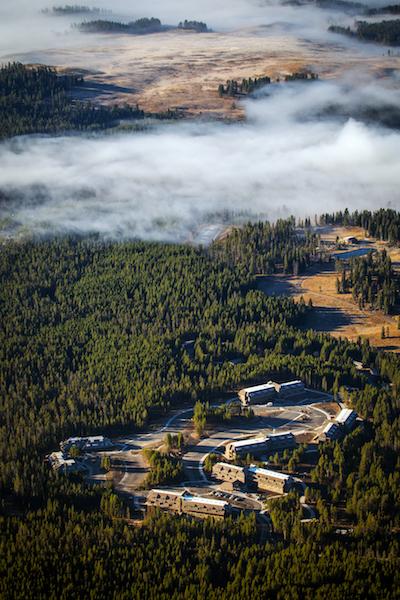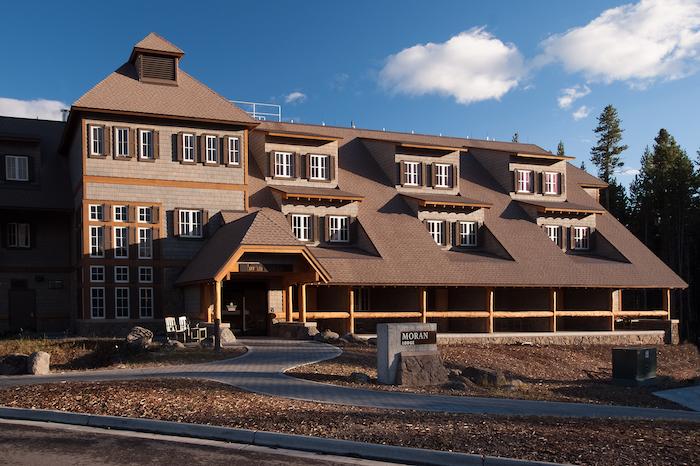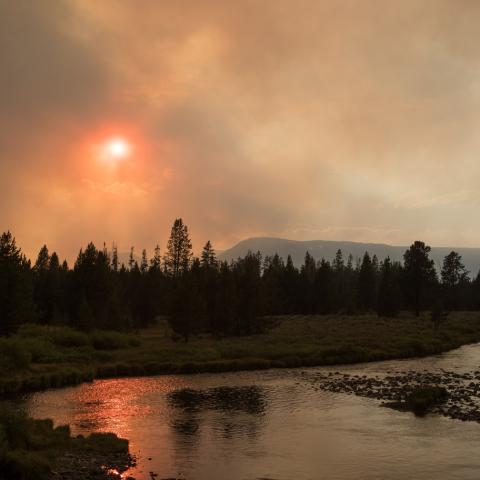They're ponderous, pavement clogging, and capable of disgorging more than 50 visitors at a time; leg-stretching, camera-toting pedestrians who often will swarm en masse onto the boardwalks ringing Yellowstone National Park's geyser basins. And in 2016, those commercial tour buses would have stretched roughly 108 miles if you had parked them end-to-end-to-end.
"Tour bus numbers have grown at kind of exponentially increasing rates. We’ve more than doubled in the last five years," said Ryan Atwell, Yellowstone's resident social scientist.
Whereas 5,411 commercial tour buses, which can stretch 45 feet and seat about 54 passengers, entered the park in 2010, last year the year grew to 12,800, according to Mr. Atwell's numbers.
That's a staggering increase, when you think about tour buses circling Yellowstone's Grand Loop Road, and parking in front of lodges. But that increase in commercial tours does not mean there are fewer lodge rooms in the park for you and me, according to Rick Hoeninghausen, sales and marketing director for Xanterra Parks & Resorts at Yellowstone.

While Mammoth Hotel is closed to guests most of this year due to renovations, all five new lodges at Canyon are available/Xanterra Parks & Resorts
“There are limits by lodge and by location as to where we can put the groups, and how many," he said the other day during a phone call. "That’s been in place for a long time. And by the way, it’s not just lodging, it’s dinner reservations as well."
While some lodging operations in Yellowstone might accept a few more bus tour groups than others, Mr. Hoeninghausen replied when asked how many rooms in the park are reserved for tour bus groups, "it's going to fluctuate a little bit on an annual basis, but in reality, when the dust settles, ir's probably going to fall around 18 percent."
"Some places we have larger amounts. Places like Grant Village, we can put more groups in Grant Village," the official went on. "But at places like Lake Lodge, very few. Old Faithful Lodge. None. Roosevelt Lodge. None."
While it might seem to those who annually search for lodging in Yellowstone that rooms are filling up earlier and earlier each year, Mr. Hoeninghausen couldn't say for sure that that was the case. He did so, however, that construction and renovation projects at the park's lodging bases are affecting how many rooms are available.
“Stuff is out of availability when we’re renovating and building this and that. I haven’t had an apples to apples room inventory for several years now," he said. "Here’s what I can tell you: campground reservations. For the last few years, advance reservations on campgrounds has been tracking higher each year. Which means more people booking earlier. And that usually tells us that A), interest is still strong in Yellowstone, and it's an indicator that lodging will probably track similarly.
"But again, Mammoth (Hotel) is off the books for most of this summer, Canyon (Lodge) is back on. Last year only a couple of Canyon lodges were on to start the year," explained Mr. Hoeninghausen. “Grant Village we’ve been renovating. We’re adding 67 new cabins to Old Faithful Lodge this year that weren’t available last year. Although, they’re not all on (available for booking) yet, because we want to make sure the construction is done on time. That’s the moving target. So, I cannot tell you for sure what’s happening with lodging with any degree of certainty, but when I look at campagrounds, the last few years they’ve been pacing ahead. That tells me that generally people may be in fact booking earlier.”
Concerning Mammoth Hotel, the National Park Service is conducting a multi-phase rehabilitation project that is expected to keep the hotel closed for guests through the coming year. The $7.9 million project, which got underway this past October, will not require closure of the cabins that surround the hotel located near the park's North Entrance near Gardiner, Montana. Inside the hotel, the project is scheduled to include:
- Seismic and structural stabilization of the lobby, Map Room, and Porte Cochere, which will require the construction of shear walls and moment frames.
- The modernization of the electrical system (including new distribution panels, restoration of historic light fixtures, and upgrades to the emergency lighting system).
- Replace the one-pipe mechanical heating system with a more efficient two-pipe thermostatic controlled system and insulate the heating pipes.
- Upgrade fire-smoke detector systems and fire-sprinkler systems.
- Improve ADA compliance and accessibility.
Against that, Xanterra will have the five new lodges at Canyon up and running this year.

Moran Lodge is one of five new lodges open for guests at Canyon in Yellowstone/Xanterra Parks & Resorts












Comments
We stayed at Mammoth Hotel in June 2016, and I was stunned by the number of tour buses we saw and the volume of humanity that poured out of them. The day we checked out, three large buses pulled in, and the front desk told me they were taking up the entire second floor of the hotel. No wonder it can be so hard to get a room even 9 months ahead of time.
It's good to know that there is a cap on reservations at hotels and restaurants for tour bus visitors, but I'm still troubled by this influx of buses. The presence of these hulking vehicles on narrow, bucolic lanes is disturbing on many levels. The people who pour out of them always seem to be in a hurry to get to and from the springs and geysers, and they have little regard for others who stand in the way of their precious selfies. We experienced roughly the same thing at Grant Teton later on.
I hope the NPS figures out a way to limit the number of buses allowed to enter Yellowstone soon. Our experience was negatively affected by these buses, and I'm sure I'm not alone in that sentiment. Families save up and plan for these once-in-a-lifetime experiences a year or more in advance. Industrial-scale tourism shouldn't become the only way to experience these natural treasures.
I can sympathize with you Cory, however I think we also need to understand that many of these groups also plan far in advance. Many are not even from this country and many don't drive. I'm not sure a tour bus is worse than having that many more additional cars filling the parking lots or the behemoth motor homes and campers that clog the parking areas either. As for being in a rush, if you are on a bus you have a set time at each destination so I can also understand or sympathize with those that want to make sure they get to see everything. There is no excuse for rude behavior aside from cultural differences which often arise with Asian visitors who are not used to waiting in lines but where squeezing your way to the front is a way of life. I'll add that Americans traveling over seas are often not much better when it comes to respecting the cultural norms in a given country. I think the real problem is the NPS believes that the more paid visitors the better. I am old enough to know how wonderful the parks were when you didn't need to make a reservation for lodging or camping nor worry about finding a parking space. Sadly those days will likely never return.
In 2015, I spent 10 daysa in the park----3 nights at Canyon----I apreciated the new rooms made available, but to get a seat at the restaurant was very difficult, since I don't think they expanded in that area to ofset the additional rooms.
imagine if all of those bus travelers came in rental cars! Many parks are using or considering shuttle buses anyway as a more effienct means of transporting visitors. However, I do hope that for-profit tour companies are being charged a premium for the use of our public resources.
We love Yellowstone in the winter, when there is practically no one else there. We avoid it like the plague during the summer months. It is a zoo and the animals are not amused by the numbers of two legged pests. I work in public health and we have to recommend rabies post exposure prophylaxis entirely too many times for stupid tourists who cannot comprehend what a wild animal is. And unfortunately, they kill animals to test them when they can find the one whose patience finally cracked. No, you don't literally stick a camera in a coyote's face as he trots down the paved road. He will bite you and you will complain about him??? Seen it numerous times...
We miss Mammoth Lodge being closed. We stay in Gardiner as we can bring the dogs that way, but we love hitting the restaurant at the lodge for XMas dinner and other long weekends. The drive to Cooke City in the winter is wilderness at its best. Hope they open the restaurant up again next winter. We like W. Yellowstone also for different reasons.
I agree with the comment that for-profit tour busses should be charged a premium for the Yellowstone experience. However, I've heard that the tour busses (who brought in 500,000 Chinese last year according to the papers)are charged less than $200 to enter the Park, and that's with 50 passengers. Would someone explain if that is not true and my information is incorrect?
Sharon - I'm a Tour Operator who brings in some of those buses to Yellowstone. I pay $500 for the bus to enter Yellowstone and an additional $500 to enter Grand TetonNP. We specialize in senior tours many of whom would never be able to see Yellowstone and our magnificent National Parks unless they came on a tour.
Sharon--
Information on entrance fees for commercial busses is on the fee page for every park: https://www.nps.gov/yell/planyourvisit/fees.htm for Yellowstone, replace YELL with the 4 letter code for any other park.
Large commercial busses pay $300 at YELL, and another $300 if the go to Grand Teton. Private vehicles pay $30 for just YELL or $50 for both. I don't know the average persons per private vehicle at those parks, but 4 should be ballpark. That's $7.50 or $12.50 each person by car, vs $6 or $12 each person for 50 people on a bus. Note that the big tours of multiple parks catering to international tourists who don't want to drive pay the $300 fee at each park. There is no equivalent of the $80 annual pass for commercial operators. So, those visitors are actually paying more to NPS than families in cars hitting several parks on vacation.
Each large bus is replacing 12+ cars on the park roads & parking lots. In terms of parking lots, each bus space could be 3 cars, but only 1 RV or trailer space. In terms of emissions, the bus is replacing those 12 vehicles not only in the park, but at least from the nearest airport (Bozeman) if not Salt Lake City or Denver. Diesel bus vs gasoline car is a bit more soot & fine particulates, but overall substantially less emissions.
Overall, on a person by person basis, large busses have less impact. The drawback is bursts of 50+ visitors at once at visitor centers, restrooms, geysers, etc., and much worse when several busses end up arriving at the same time. Some things can be done to mitigate those bursts, but as long as busses make up a small fraction of the visitors at each location, other capacity issues are more important than those bursts.
If I were in charge of Yellowstone and had an extra $10M, I would open scoping and public comment on the equivalent of the Denali busses for at least the main loop and 4 main entrances. Hop on hop off LNG busses every half hour or so would maximize the benefits of busses while minimizing many of the drawbacks, and might replace 1/4 or more of the cars on the roads and improve the experience for some visitors. I suspect that many visitors would be happy to drive to their campground or hotel, but then pay $10 or so for a day pass for a hop on hop off bus instead of a frustrating day driving in traffic and hunting for parking. [Have no fear: I will never be in charge of YELL, and I will never have an extra $10M.]
As far as commercial tour operators and other commercial uses of parks, the law basically doesn't allow NPS to charge a premium. Tour operators pay those entrance fees in leiu of each passenger paying separately. Other users such as movie & commercial shooting pay a (very) modest location or application & permit fee that goes to the region with some fraction returning to the park, plus overtime for however many employees are needed for public safety and monitoring to prevent resource damage during their use. Researchers need to apply for a research permit and not impact the park resources or visitors, but generally don't pay a fee. However, NPS gets a licensing cut from any discoveries made in the park. If someone finds another TAQ polymerase in YELL, NPS will get a tidy stream of revenue (not sure if to NPS or the US Treasury).